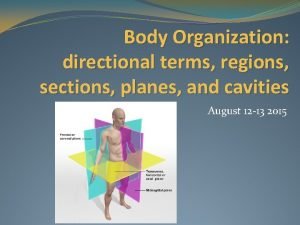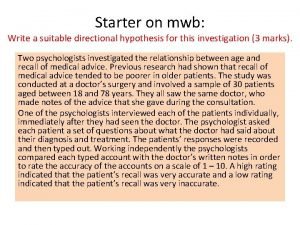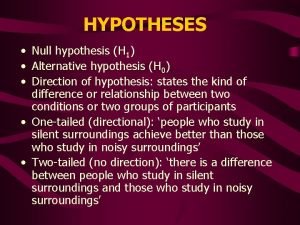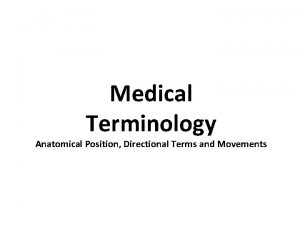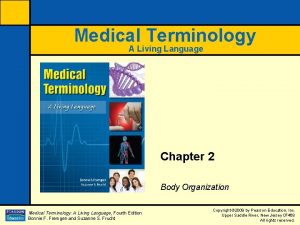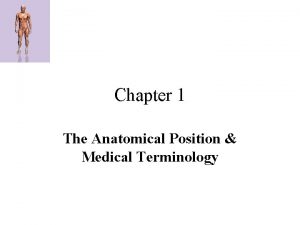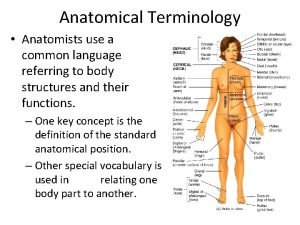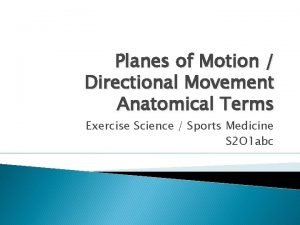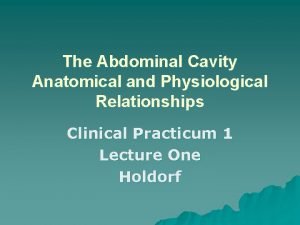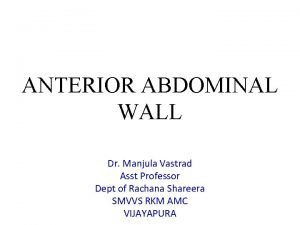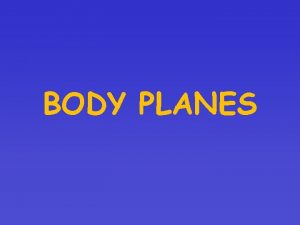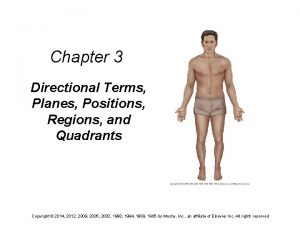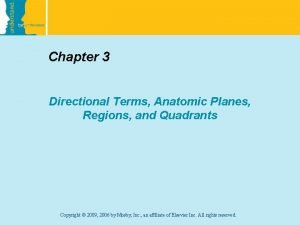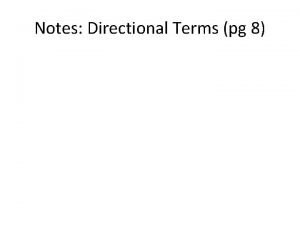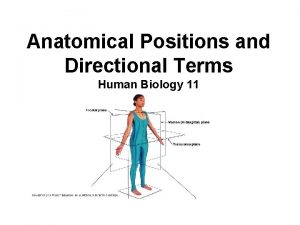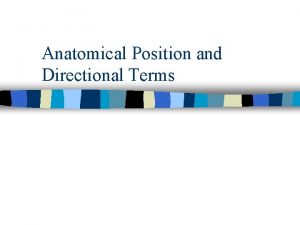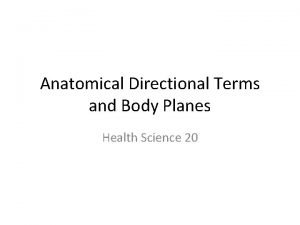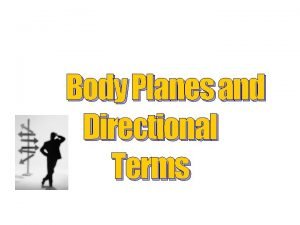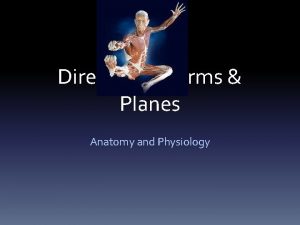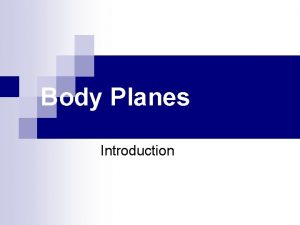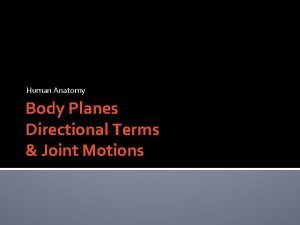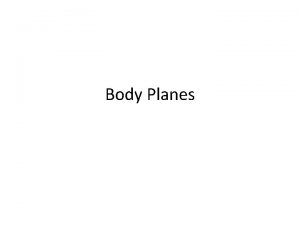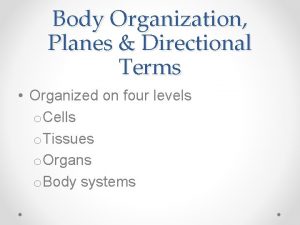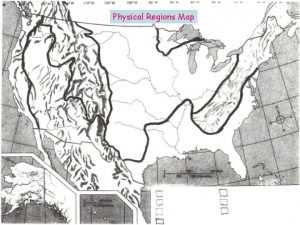Chapter 3 Directional Terms Planes Positions Regions and































- Slides: 31

Chapter 3 Directional Terms, Planes, Positions, Regions, and Quadrants Copyright © 2014, 2012, 2009, 2005, 2002, 1998, 1994, 1989, 1985 by Mosby, Inc. , an affiliate of Elsevier Inc. All rights reserved.

Purpose of Directional Terms, Planes, Positions, Regions, and Quadrants • directional terms: used to describe the relative position of one part of the body to another • anatomic planes: used to identify or view the location of organs and anatomical structures • body position terms: used to communicate how the patient’s body is placed for examination, diagnostic procedures, surgery, treatment, and recovery Copyright © 2014, 2012, 2009, 2005, 2002, 1998, 1994, 1989, 1985 by Mosby, Inc. , an affiliate of Elsevier Inc. All rights reserved. 2

Purpose of Directional Terms, Planes, Positions, Regions, and Quadrants (cont’d) • abdominopelvic regions: used in relation to physical examination and medical history to describe signs and symptoms • Abdominopelvic quadrants: division of the abdominopelvic area into four quadrants by using imaginary vertical and horizontal lines that intersect at the umbilicus Copyright © 2014, 2012, 2009, 2005, 2002, 1998, 1994, 1989, 1985 by Mosby, Inc. , an affiliate of Elsevier Inc. All rights reserved. 3

Anatomic Position • Body is viewed as erect, arms at the side with palms of the hands facing forward, and feet placed side by side pointed anteriorly. • Whether the patient is standing or lying down face up, the directional terms are the same. Copyright © 2014, 2012, 2009, 2005, 2002, 1998, 1994, 1989, 1985 by Mosby, Inc. , an affiliate of Elsevier Inc. All rights reserved. 4

Chapter 3 Objective 1: Define and spell word parts related to directional terms. Copyright © 2014, 2012, 2009, 2005, 2002, 1998, 1994, 1989, 1985 by Mosby, Inc. , an affiliate of Elsevier Inc. All rights reserved. 5

Combining Forms for Directional Terms • • • anter/o caud/o cephal/o dist/o dors/o infer/o • • • later/o medi/o poster/o proxim/o super/o ventr/o Copyright © 2014, 2012, 2009, 2005, 2002, 1998, 1994, 1989, 1985 by Mosby, Inc. , an affiliate of Elsevier Inc. All rights reserved. 6

Prefixes and Suffixes • Prefixes § bi§ uni- • Suffixes § -ad § -ior Copyright © 2014, 2012, 2009, 2005, 2002, 1998, 1994, 1989, 1985 by Mosby, Inc. , an affiliate of Elsevier Inc. All rights reserved. 7

Review Question Which of the following is a prefix? a) bib) -ad c) dist/o Copyright © 2014, 2012, 2009, 2005, 2002, 1998, 1994, 1989, 1985 by Mosby, Inc. , an affiliate of Elsevier Inc. All rights reserved. 8

Chapter 3 Objective 2: Define, pronounce, and spell terms used to describe directions with respect to the body. Copyright © 2014, 2012, 2009, 2005, 2002, 1998, 1994, 1989, 1985 by Mosby, Inc. , an affiliate of Elsevier Inc. All rights reserved. 9

Directional Terms (animation on Student Evolve site) • caudad • cephalad • • lateral (lat) medial unilateral bilateral • distal • proximal Copyright © 2014, 2012, 2009, 2005, 2002, 1998, 1994, 1989, 1985 by Mosby, Inc. , an affiliate of Elsevier Inc. All rights reserved. 10

Directional Terms (cont’d) • inferior • superior • caudal • cephalic • anterior • posterior • dorsal • ventral • anteroposterior (AP) • posteroanterior (PA) Copyright © 2014, 2012, 2009, 2005, 2002, 1998, 1994, 1989, 1985 by Mosby, Inc. , an affiliate of Elsevier Inc. All rights reserved. 11

Review Question Which of the following means two sides? a) unilateral b) lateral c) bilateral Copyright © 2014, 2012, 2009, 2005, 2002, 1998, 1994, 1989, 1985 by Mosby, Inc. , an affiliate of Elsevier Inc. All rights reserved. 12

Chapter 3 Objective 3: Define, pronounce, and spell terms used to describe the anatomic planes. Copyright © 2014, 2012, 2009, 2005, 2002, 1998, 1994, 1989, 1985 by Mosby, Inc. , an affiliate of Elsevier Inc. All rights reserved. 13

Anatomic Planes • frontal or coronal: vertical plane passing through the body from side to side, dividing the body into anterior and posterior portions • midsagittal: vertical plane passing through the body from front to back at the midline, dividing body equally into right and left halves • sagittal: vertical plane passing through the body from front to back, dividing body into right and left sides (any plane parallel to the midsagittal plane) Copyright © 2014, 2012, 2009, 2005, 2002, 1998, 1994, 1989, 1985 by Mosby, Inc. , an affiliate of Elsevier Inc. All rights reserved. 14

Anatomic Planes (cont’d) • parasagittal: vertical plane passing through the body from front to back, dividing the body into unequal left and right sides • transverse: horizontal plane dividing the body into superior and inferior portions Copyright © 2014, 2012, 2009, 2005, 2002, 1998, 1994, 1989, 1985 by Mosby, Inc. , an affiliate of Elsevier Inc. All rights reserved. 15

Anatomic Planes (cont’d) Copyright © 2014, 2012, 2009, 2005, 2002, 1998, 1994, 1989, 1985 by Mosby, Inc. , an affiliate of Elsevier Inc. All rights reserved. 16

Review Question Copyright © 2014, 2012, 2009, 2005, 2002, 1998, 1994, 1989, 1985 by Mosby, Inc. , an affiliate of Elsevier Inc. All rights reserved. 17

Chapter 3 Objective 4: Define, pronounce, and spell terms used to describe body positions. Copyright © 2014, 2012, 2009, 2005, 2002, 1998, 1994, 1989, 1985 by Mosby, Inc. , an affiliate of Elsevier Inc. All rights reserved. 18

Body Positions • Fowler position: semi-sitting position with slight elevation of the knees • lithotomy position: lying on back, hips and knees flexed, thighs abducted and externally rotated • prone position: lying on abdomen, facing downward (head may be turned to one side) • orthopnea position: sitting erect in a chair or sitting upright in bed supported by pillows behind the head and chest (also called orthopneic position) Copyright © 2014, 2012, 2009, 2005, 2002, 1998, 1994, 1989, 1985 by Mosby, Inc. , an affiliate of Elsevier Inc. All rights reserved. 19

Body Positions (cont’d) • recumbent position: lying down in any position • Sims position: lying on left side with right knee drawn up and with left arm drawn behind, parallel to the back • supine position: lying on back, facing upward • Trendelenburg position: lying on back with body tilted so that the head is lower than the feet Copyright © 2014, 2012, 2009, 2005, 2002, 1998, 1994, 1989, 1985 by Mosby, Inc. , an affiliate of Elsevier Inc. All rights reserved. 20

Review Question Copyright © 2014, 2012, 2009, 2005, 2002, 1998, 1994, 1989, 1985 by Mosby, Inc. , an affiliate of Elsevier Inc. All rights reserved. 21

Chapter 3 Objective 5: Define, pronounce, and spell terms used to describe the abdominopelvic regions. Copyright © 2014, 2012, 2009, 2005, 2002, 1998, 1994, 1989, 1985 by Mosby, Inc. , an affiliate of Elsevier Inc. All rights reserved. 22

Abdominopelvic Regions • To assist medical personnel in locating medical problems with greater accuracy and for identification purposes, the abdomen is divided into nine regions: – hypochondriac (right & left) – epigastric – lumbar (right & left) – umbilical – iliac (right & left) (also called inguinal regions) – hypogastric Copyright © 2014, 2012, 2009, 2005, 2002, 1998, 1994, 1989, 1985 by Mosby, Inc. , an affiliate of Elsevier Inc. All rights reserved. 23

Abdominopelvic Regions (cont’d) Copyright © 2014, 2012, 2009, 2005, 2002, 1998, 1994, 1989, 1985 by Mosby, Inc. , an affiliate of Elsevier Inc. All rights reserved. 24

Chapter 3 Objective 6: Identify and spell the four abdominopelvic quadrants. Copyright © 2014, 2012, 2009, 2005, 2002, 1998, 1994, 1989, 1985 by Mosby, Inc. , an affiliate of Elsevier Inc. All rights reserved. 25

Abdominopelvic Quadrants (animation on Student Evolve site) Copyright © 2014, 2012, 2009, 2005, 2002, 1998, 1994, 1989, 1985 by Mosby, Inc. , an affiliate of Elsevier Inc. All rights reserved. 26

Review Question Copyright © 2014, 2012, 2009, 2005, 2002, 1998, 1994, 1989, 1985 by Mosby, Inc. , an affiliate of Elsevier Inc. All rights reserved. 27

Chapter 3 • Objective 7: Interpret the meaning of abbreviations presented in this chapter. Copyright © 2014, 2012, 2009, 2005, 2002, 1998, 1994, 1989, 1985 by Mosby, Inc. , an affiliate of Elsevier Inc. All rights reserved. 28

Abbreviations • • • ant AP inf lat LLQ • LUQ • med • PA • RLQ • RUQ • sup Copyright © 2014, 2012, 2009, 2005, 2002, 1998, 1994, 1989, 1985 by Mosby, Inc. , an affiliate of Elsevier Inc. All rights reserved. 29

Chapter 3 Objective 8: Interpret, read, and comprehend medical language in simulated medical statements, documents, and electronic health records. Copyright © 2014, 2012, 2009, 2005, 2002, 1998, 1994, 1989, 1985 by Mosby, Inc. , an affiliate of Elsevier Inc. All rights reserved. 30

Medical Document The patient presented to her physician with pain in the right lumbar region and right unilateral leg pain. The pain was felt in the posterior portion of the leg and radiated to the distal lateral portion of the extremity. There was some proximal muscle weakness reported of the affected leg. A lumbar spine radiograph was normal. If the pain does not respond to antiinflammatory medication, she will be referred to an orthopedist. Copyright © 2014, 2012, 2009, 2005, 2002, 1998, 1994, 1989, 1985 by Mosby, Inc. , an affiliate of Elsevier Inc. All rights reserved. 31
 Body directional terms
Body directional terms Directional hypothesis example
Directional hypothesis example Hypothesis testing
Hypothesis testing Directional and non directional hypothesis
Directional and non directional hypothesis Formulating and clarifying the research topic
Formulating and clarifying the research topic What is directional and non directional hypothesis
What is directional and non directional hypothesis Directional and non directional hypothesis
Directional and non directional hypothesis Directional hypothesis example
Directional hypothesis example Anatomical position examples
Anatomical position examples Positional and directional terms
Positional and directional terms The midsagittal plane divides the body into
The midsagittal plane divides the body into Positional and directional terms
Positional and directional terms Medical body terms
Medical body terms Transverese plane
Transverese plane Directional terms
Directional terms Supine position
Supine position Medical term posterior
Medical term posterior Directional terms - examples
Directional terms - examples 4 quadrants of the body
4 quadrants of the body Anatomical position medical terminology
Anatomical position medical terminology Directional terms anatomy
Directional terms anatomy Body organization and terminology lab 2
Body organization and terminology lab 2 Directional terminology
Directional terminology Brain directional terms
Brain directional terms Body location terms
Body location terms Planes and regions of abdomen
Planes and regions of abdomen Abdomen 9 regions
Abdomen 9 regions Glisside
Glisside Like terms and unlike terms in polynomials
Like terms and unlike terms in polynomials Like terms
Like terms Chapter 7.2 body planes directions and cavities
Chapter 7.2 body planes directions and cavities Basic geometric figures lesson 1-1
Basic geometric figures lesson 1-1
